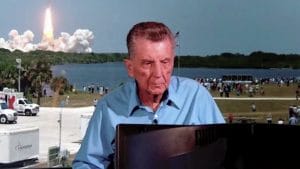A journalist, Barbree was working at a Georgia radio station when, in 1957, he reported on an event that gripped the world: the launch, by Russia, of the first artificial satellite, Sputnik. He was so fascinated that he paid his way to Cape Canaveral later that year to witness the launch of the U.S. response, Vanguard TV-3. “There’s ignition!” he reported to listeners. “We can see the flames. Vanguard’s engine is lit and it’s burning. But wait… wait a moment, there’s… there’s no liftoff. It appears to be crumbling in its own fire…. It’s burning on the pad…. Vanguard has crumbled into flames. It failed ladies and gentlemen, Vanguard has failed.”
But he was back to watch Explorer 1 successfully launch on January 31, 1958 — and again called in his report to WALB in Georgia. He was hired by WEZY in Cocoa Beach to be near the Cape, but was quickly snapped up to report on NASA and launches for the NBC network. He was good enough that he was offered promotions to work in New York City and Washington D.C., among other posts, but Barbree turned the offers down, preferring to stay in Florida to cover the space program. He was present for every non-commercial space launch, from satellites to Mercury, Gemini, Apollo, and every one of the 135 Space Shuttle flights. In all, he was present for 166 human space launches. The first was Alan Shepard, who had confided to Barbree privately that he was chosen to be that first astronaut, but Barbree kept it quiet to not damage their friendship — or Shepherd’s chances to go. “That was a day that you’ll never forget,” he said in 2007. “We saw that rocket climb above the tree lines — everybody everywhere stopped. They stopped their cars, they fell on their knees, they fell in prayer watching this go. Everybody was pulling for Alan Shepard, and that was the very first for this country.” In 1995, NASA gave him a special award as the only journalist to have covered all 100 (to that time) NASA manned space launches.

“The bottom line comes down to this,” he said on the 50th anniversary of the first space launch. “This is an 8,000-mile diameter spacecraft we’re on. We’re all astronauts. We’re all living in a life support system that is only 10,000 feet in thickness, that’s keeping us alive on this planet. The day will come, if it’s not a genetic virus, if it’s not global warming, whatever, the day will come that we can no longer live on this planet. The only solution is to step off it to colonization of the moon and onto other planets. There are 150 or so planets that we could live on that in the coming years we’ll be able to reach.” As for “Mars, I’m afraid that’ll be in the 2030s,” and hoped he might be around to cover that launch too. “How the Armstrongs, the Aldrins, the Glenns — all of us who were here for Mercury, Gemini and Apollo — would like to be around for the 21st century’s greatest adventure!” But he retired in 2017 — yet still consulted with the Discovery Channel, National Geographic, and the American Spaceflights website. He died — in, of course, Florida — on May 14, at 87.
Barbree’s Space Program books *:
- Moon Shot: The Inside Story of America’s Apollo Moon Landings (1994, with Alan Shepard and Deke Slayton)
- “Live from Cape Canaveral”: Covering the Space Race, from Sputnik to Today (2008)
- Neil Armstrong: A Life of Flight (2014).
